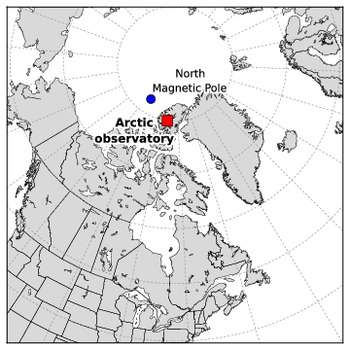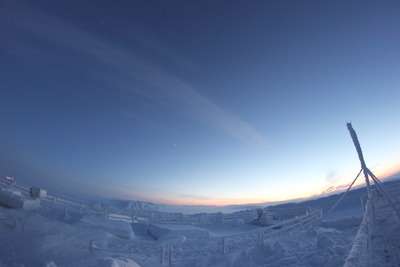The Canadian High Arctic offers continuous darkness during the winter months -- an enormous advantage for astronomers searching for repeating events like planetary transits of stars. Exceptionally clear, arctic winter skies and calm atmospheric conditions also make for excellent conditions for astronomy.
In February 2012, members of a team of astronomers and graduate students from the University of Toronto and the National Research Council braved -40 degrees Celcius temperatures to perform the first astronomical surveys, and continue measurements of atmospheric turbulence, at the Polar Environment Atmospheric Research Laboratory (PEARL) on Ellesmere Island. Since 2009, the National Research Council has been organizing observations at PEARL. The results confirm the observatory -- at 80 degrees North -- as among the best in the world; it is an excellent location from which to search for exoplanets, an excellent future home for the half-metre Dunlap Institute Arctic Telescope, and an important opportunity to establish a unique astronomical facility in Canada.
The team tested two Arctic Wide-field Cameras (AWCams) at Environment Canada’s Polar Environment Atmospheric Research Laboratory (PEARL), located 15 kilometres from Eureka, Nunavut. The AWCams are designed to search for transiting exoplanets around nearby, bright stars. In the High Arctic, without the interruption of daylight, such cyclical events are much more likely to be detected, especially at the longer orbital periods which are very difficult to reach from current ground-based observatories.
The top of the Ridge Lab roof, where our cameras were deployed.
In total, the AWCams took over 44,000 images and produced precision light curves for approximately 70,000 stars. In research submitted to the Astrophysical Journal, Co-Principal Investigator Nicholas Law and the team demonstrate that the cameras can achieve the performance necessary to detect planets as small as Neptune around thousands of nearby stars like our sun, laying the groundwork for a more extensive survey next winter.
According to Law, “Finding planets around nearby stars is particularly important. Because of their proximity to us, we can obtain a much more detailed understanding of their atmospheres and compositions compared to more distant worlds.” In addition, the data collected is currently being used for variable star measurements, and to search for transient events like supernovae and micro-lensing events.
The researchers also measured the atmospheric turbulence, or astronomical seeing, at the site—a condition vital to understand before placing larger telescopes at the location. Graduate student, Wayne Ngan , spent 17 days at PEARL and says, “Despite the challenges of working in a cold, dark, and windy location, our tests indicate that the location has excellent potential for large telescopes like the Dunlap Institute’s half-meter telescope that’s currently undergoing testing in New Mexico.”
Law and the team look forward to returning to Ellesmere Island later this year. “Because of the continuous winter darkness, relative ease of access via the PEARL laboratory, and excellent astronomical conditions,” says Law, “we are all very excited about the arctic site’s exceptional potential.”
Provided by Canadian Astronomical Society
























